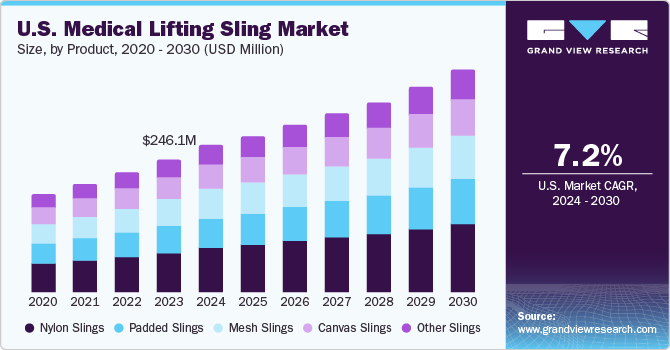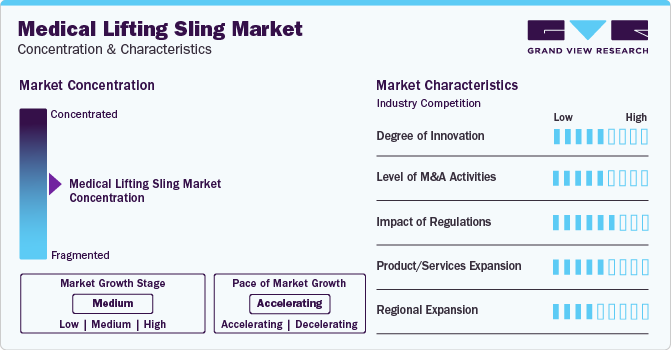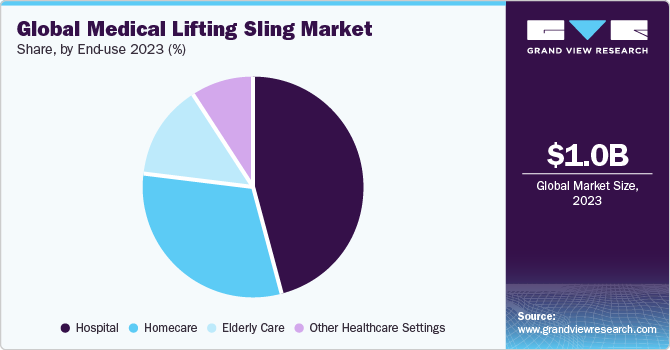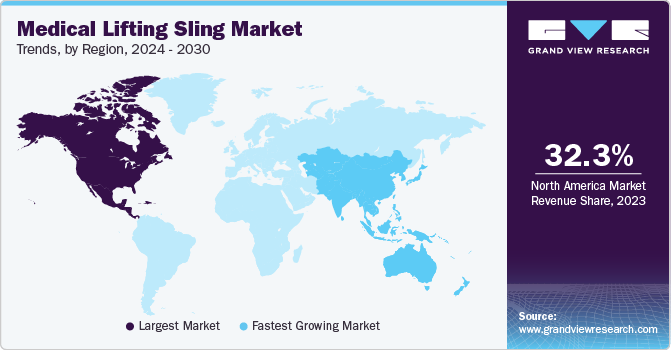- Home
- »
- Medical Devices
- »
-
Medical Lifting Sling Market Size And Share Report, 2030GVR Report cover
![Medical Lifting Sling Market Size, Share & Trends Report]()
Medical Lifting Sling Market Size, Share & Trends Analysis Report By Product (Nylon, Padded), By Application (Transfer Slings, Universal Slings), By Usage, By End-use, By Region, And Segment Forecasts, 2024 - 2030
- Report ID: GVR-1-68038-249-5
- Number of Report Pages: 95
- Format: PDF, Horizon Databook
- Historical Range: 2018 - 2022
- Forecast Period: 2024 - 2030
- Industry: Healthcare
Medical Lifting Sling Market Size & Trends
The global medical lifting sling market size was estimated at USD 1.01 billion in 2023 and is projected to grow at a compound annual growth rate (CAGR) of 7.6% from 2024 to 2030. The increase in the prevalence of the geriatric population, rising incidences of chronic disorders requiring long-term care, and the rise in the number of physically disabled people are the primary factors that are driving the market growth.

According to the India Ageing Report 2023, the number of older individuals worldwide is anticipated to double to 2.1 billion by 2050. Out of which, approximately 1.3 billion older individuals are estimated to be in Asia. Thus, the rising prevalence of the geriatric population is expected to propel the market.
Furthermore, the demand for medical lifting products is expected to be driven by the increasing prevalence of chronic conditions among geriatric people. Older individuals are at a higher risk of developing musculoskeletal conditions like arthritis, bone & hip fractures, and osteoporosis. According to the article published by the Centers for Disease Control and Prevention (CDC) in May 2023, at least 300,000 olde individuals are hospitalized for hip fractures annually. In addition, the study published by Medical Science and Discovery in March 2023 found that around 95.3% of older people reported musculoskeletal problems in a district survey conducted in Maharashtra, India. Thus, the rising musculoskeletal conditions among older individuals can drive the demand for medical lifting products.
Moreover, the rise in the number of physically disabled people is expected to propel the development of medical lifting products in the coming years. According to the article published by the World Health Organization (WHO) in March 2023, an estimated 1.3 billion people experience significant disability across the globe. In addition, as per the article published by the Department of Empowerment for Persons with Disabilities in August 2021, in India, around 20% of disabled individuals have a disability in movement. Thus, the large number of individuals having movement disability is expected to boost the demand for the medical lifting slings market.
Market Characteristics
Market growth stage is medium, and the pace of the market growth is accelerating. The global market is characterized by a moderate degree of innovation due to increasing launches of novel products. Companies are bringing innovative products into the industry, which are expected to drive innovation in the industry. For instance, in March 2023, Care & Independence introduced four new in-situ slings to provide full body support, including femur support from behind the knees to the hips. Such novel offerings are driving innovation in the industry.

The market is also characterized by a moderate level of merger and acquisition (M&A) activities from the major players. This is due to several factors, including the desire to gain a competitive advantage in the industry and the need to consolidate in a rapidly growing market. The merger and acquisition strategy helps the companies operating in the market to reduce costs, improve care outcomes, and provide opportunities for innovating their product offerings.
Furthermore, the industry participants operating in the industry are focusing on increasing their presence in regions and improving access to medical devices including lifting slings. For instance, in June 2023, Joerns Healthcare , a healthcare equipment and technology company, partnered with Winncare, a leading European mobility solutions provider. Winncare provides Lifting Cushion products. The companies partnered to introduce moving and handling product range to the U.S. market. This strategy helps companies distribute their products to a large number of customers across the U.S. Thus, such distribution partnerships among the industry participants are expected to improve the reach of their products across the globe.
Product Insights
Based on product, the nylon slings segment led the market in 2023 with the largest revenue share of 29.65%. It is also expected to grow fastest CAGR over the forecast period. This dominance can be attributed to its durability as well as resistance to infections. Nylon-based slings are thin & flexible in nature and primarily compatible with standing-support slings. It can handle a load of up to 300,000 pounds (136,363 kilograms) and offers the convenience to conform to any shape. In addition, these slings are resistant to temperature. Nylon-based medical lifting slings offer benefits such as efficient durability, reusability, and availability in multiple shapes and sizes. These factors are expected to drive the segment’s growth over the forecast period.
The padded segment is anticipated to witness the second-fastest CAGR over the forecast period. Padded medical lifting slings are designed to prevent sliding (brush-lined) and to increase patient comfort and skin protection. These types of slings are covered and stretch resistant. Padded medical lifting slings are usually made of polyester fabric material that is washable and can be used in wet or dry environments. In addition, the padded medical lifting slings are majorly used by amputees and have major applications in toileting. Generally, padded medical lifting slings are well-padded under the arms and in the lumbar area to offer support and maximum comfort. The padded medical lifting segment is anticipated to exhibit favourable growth during the forecast period due to increased comfortability coupled with the safety offered by these slings.
Application Insights
In terms of application, the transfer slings segment led the market with the largest revenue share of 29.35% in 2023. The dominance of the segment can be attributed to its application, which includes transferring patients to and or from a chair, bed, and the floor. Patient transfer is the prime application of medical lifting slings, which includes the transfer of a patient from bed to floor or floor to the bed, transferring users or amputees from a horizontal to a seated position, or vice-versa. Owing to its varied utility and better adjustability, the transfer segment is expected to dominate the medical lifting slings market throughout the forecast period.
The universal slings segment is projected to witness the second fastest CAGR over the forecast period. These multi-purpose slings come with leg, hip, shoulder, and side straps to provide better support and distribute weight. The universal slings are easy to use and comfortable. These slings are available in mesh, padded fabric, or quilted material and are used for multiple purposes, such as toileting, bathing, and other general purposes.
Usage Insights
Based on usage, the reusable medical lifting slings segment led the market with a largest revenue share of 57.75% in 2023. The dominance of the segment can be because they can be used and washed multiple times. Most of the reusable slings can be used for patients with limited upper body function (head support) and are controlled by the caregiver. In addition, reusable slings are designed to make a move, roll, or turn a patient easily. These types of slings are usually made from polyester and yarn to enhance comfort and reduce shear by adjusting to the contours of the body.
The disposable segment is projected to witness the fastest CAGR over the forecast period. Disposable slings are designed for a single user and disposed after their use. The increasing rate of hospital-borne diseases and cross-infection due to reusable products is the primary reason for professionals to switch to disposable products. These slings can be easily disposed of to prevent cross-contamination when they become dirty. The sling is made from environmentally friendly material. Thus, such aforementioned factors are expected to propel the segment growth over the forecast period.
End-use Insights
Based on end-use, the hospital segment led the market with a largest revenue share of 46.38% in 2023. The huge patient pool and a greater financing capability facilitate bulk purchasing of medical lifting slings in hospitals. Medical lifting slings are majorly used in hospitals to transfer patients who have mobility-related disorders. The increasing bulk purchase of medical lifting slings due to their limited product life and the rising use of medical lifting slings in hospitals for assisting disabled patients is anticipated to propel the segment growth over the forecast period.

The homecare segment is projected to witness the fastest CAGR over the forecast period. As compared to hospitals, home healthcare services offer an economic benefit. In addition, medical lifting slings are an essential part of home health care (after the surgery) when a user or an amputee needs to get up from a sitting position or out of bed and/or move from one place to another at home. Moreover, these slings are useful when the user is effortlessly lifted from a bed and transferred to a wheelchair, bath, or commode without any strain to the caregiver or risk to the occupant.
Regional Insights
North America dominated the market with a revenue share of 32.25% in 2023. The dominance of the region is due to increasing chronic diseases resulting from various lifestyle diseases such as cardiovascular disease (CVD) and diabetes in the U.S. and Canada. The primary factors contributing to the growth of this region include government support for quality healthcare, high purchasing power parity, availability of reimbursement, and the increasing prevalence of chronic diseases in the U.S.

The U.S. market is expected to grow the fastest CAGR over the forecast period due to the presence of key players like Invacare Corporation Invacare Corporation, Baxter International Inc., and Joerns Healthcare LLC.
Asia Pacific market is anticipated to witness the fastest CAGR over the forecast period. Increasing per capita income and economic development and the high unmet needs of the huge population pool in this region are expected to contribute toward significant growth. Growing awareness about rehabilitation equipment, a rising number of physicians, and favourable government programs & policies are expected to boost growth in this region. The rapid adoption of new products amongst patients is also contributing to the market growth.
The China market is expected to grow the fastest CAGR over the forecast period due to the availability of major e-commerce giants like Alibaba and Amazon. These platforms are offering medical lifting sling products in China, which is increasing the e-commerce accessibility of products. Thus, the easy availability of products via digital platforms is expected to drive the country’s market in the forecast period.
The Japan market is expected to grow the fastest CAGR over the forecast period due to the availability of key players like Arjo offering the medical lifting slings in the country market. In addition, the rising prevalence of older population across the country is expected to support the market's growth over the forecast period.
The Europe market is expected to grow as a lucrative region in this industry. This growth is attributable to higher research expenditure and more initiatives that provide advanced products and private-public partnerships. In addition, the high prevalence of musculoskeletal diseases and the introduction of supportive reimbursement schemes are anticipated to be the vital factors propelling the market growth. According to the article published by the International Osteoporosis Foundation in October 2023, more than 4.3 million fragility fractures occurred in 2019 in Europe. Thus, such increasing incidences of musculoskeletal conditions are projected to boost the demand for medical lifting slings in the region.
The UK market is expected to grow the fastest CAGR over the forecast period due to the continuously rising population with physical disabilities. According to the report published by the Commons Library Research Briefing in August 2023, around 16.0 million individuals in the UK had a disability in the financial year 2021/22.
The France market is expected to grow the fastest CAGR over the forecast period due to the increasing prevalence of the geriatric population across the country. As per the article published by Le Monde in March 2023, around 26% of people living in France are over 60. The older population majorly needs the lifting slings products.
The Germany market is expected to grow the fastest CAGR over the forecast period due to continuous investment in research and innovation by medical device manufacturers in Germany and the rising prevalence of musculoskeletal conditions in the country.
Key Medical Lifting Sling Company Insights
Some of the leading players operating in the global market include Arjo, Invacare Corporation, Baxter, and Etac AB, among others. The key players are undertaking various strategies to strengthen their position in the industry. Companies are involved in launching new products and acquiring other industry participants to strengthen their position in markets.
Emerging players such as Spectracare, Joerns Healthcare, and Silvalea Ltd are undertaking different strategies. Emerging players are showcasing and presenting their products at conferences, exhibitions, or events to increase awareness about their medical lifting slings products.
Key Medical Lifting Companies:
The following are the leading companies in the medical lifting sling market. These companies collectively hold the largest market share and dictate industry trends. Financials, strategy maps & products of these medical lifting sling companies are analyzed to map the supply network.
- Arjo
- Invacare Corporation.
- Baxter (Hill-Rom)
- Joerns Healthcare
- Prism Healthcare Ltd
- DJO, LLC
- Spectracare
- V. Guldmann A/S
- Silvalea ltd
- Etac AB
Recent Developments
-
In May 2023, SSM Health introduced the LIFTsmart Program. This program provided slings, lateral transfers and repositioning, lifts, and standing and raising aids to patients
-
In April 2023, Etac AB, a key industry player, extended the range of Molift UnoSlings for single-patient use. The company offered single patient use slings for different situations and transfers, such as supine transfers, seated transfers, gait training, etc.
-
In January 2023, Winncare, a major medical device manufacturer, introduced the new complete Supine Transfer System, which helps lift patients safely and quickly. This system is portable and convenient
Medical Lifting Sling Market Report Scope
Report Attribute
Details
Market size value in 2024
USD 1.12 billion
Revenue forecast in 2030
USD 1.74 billion
Growth rate
CAGR of 7.6% from 2024 to 2030
Base year for estimation
2023
Historical data
2018 - 2022
Forecast period
2024 - 2030
Quantitative units
Revenue in USD million/billion and CAGR from 2024 to 2030
Report coverage
Revenue forecast, company ranking, competitive landscape, growth factors, and trends
Segments covered
Product, application, usage, end-use, region
Regional scope
North America; Europe; Asia Pacific; Latin America; MEA
Country scope
U.S.; Canada; Germany; UK; France; Italy; Spain; Denmark; Sweden; Norway; China; Japan; India; South Korea; Australia; Thailand; Brazil; Mexico; Argentina; South Africa; Saudi Arabia; Kuwait; and UAE
Key companies profiled
Arjo; Invacare Corporation.; Baxter (Hill-Rom); Joerns Healthcare; Prism Healthcare Ltd; DJO; LLC; Spectracare; V. Guldmann A/S; Silvalea ltd
Customization scope
Free report customization (equivalent up to 8 analyst’s working days) with purchase. Addition or alteration to country, regional & segment scope
Pricing and purchase options
Avail customized purchase options to meet your exact research needs. Explore purchase options
Global Medical Lifting Sling Market Report Segmentation
This report forecasts revenue growth at global, regional, and country levels and provides an analysis of the latest industry trends in each of the sub-segments from 2018 to 2030. For this report, Grand View Research has segmented the global medical lifting sling market report based on product, application, usage, size, end-use and region.
-
Product Outlook (Revenue, USD Million, 2018 - 2030)
-
Nylon Slings
-
Padded Slings
-
Mesh Slings
-
Canvas Slings
-
Other Slings
-
-
Application Outlook (Revenue, USD Million, 2018 - 2030)
-
Transfer Slings
-
Universal Slings
-
Hammock Slings
-
Standing Slings
-
Seating Slings
-
Toileting Slings
-
Bariatric Slings
-
Other Slings
-
-
Usage Outlook (Revenue, USD Million, 2018 - 2030)
-
Reusable Slings
-
Disposable Slings
-
-
End-Use Outlook (Revenue, USD Million, 2018 - 2030)
-
Hospital
-
Homecare
-
Elderly Care
-
Other Healthcare Settings
-
-
Regional Outlook (Revenue, USD Million, 2018 - 2030)
-
North America
-
U.S.
-
Canada
-
-
Europe
-
UK
-
Germany
-
France
-
Spain
-
Italy
-
Denmark
-
Sweden
-
Norway
-
-
Asia Pacific
-
Japan
-
China
-
India
-
Australia
-
South Korea
-
Thailand
-
-
Latin America
-
Brazil
-
Mexico
-
Argentina
-
-
Middle East & Africa
-
South Africa
-
Saudi Arabia
-
UAE
-
Kuwait
-
-
Frequently Asked Questions About This Report
b. The global medical lifting sling market size was estimated at USD 1.01 billion in 2023 and is expected to reach USD 1.12 billion in 2024.
b. The global medical lifting sling market is expected to grow at a compound annual growth rate of 7.6% from 2024 to 2030 to reach USD 1.74 billion by 2030.
b. Europe dominated the medical lifting sling market with a share of 32.2% in 2023. This is attributable to higher research expenses and initiatives that provide advanced devices and private-public partnerships.
b. Some key players operating in the medical lifting sling market include Getinge Group (ArjoHuntleigh), Invacare Corporation, Hill-Rom, Joerns Healthcare LLC, Argo Medical, Inc., Prism Medical, DJO Global, V.Guldmann A/S, Spectra Care Group, and Drive Medical.
b. Key factors that are driving the medical lifting sling market growth include the increasing prevalence of chronic diseases, the rapidly growing population, increasing availability of home healthcare services, and staff.
Share this report with your colleague or friend.
![gvr icn]()
NEED A CUSTOM REPORT?
We can customize every report - free of charge - including purchasing stand-alone sections or country-level reports, as well as offer affordable discounts for start-ups & universities. Contact us now
![Certified Icon]()
We are GDPR and CCPA compliant! Your transaction & personal information is safe and secure. For more details, please read our privacy policy.
We are committed towards customer satisfaction, and quality service.
"The quality of research they have done for us has been excellent."





